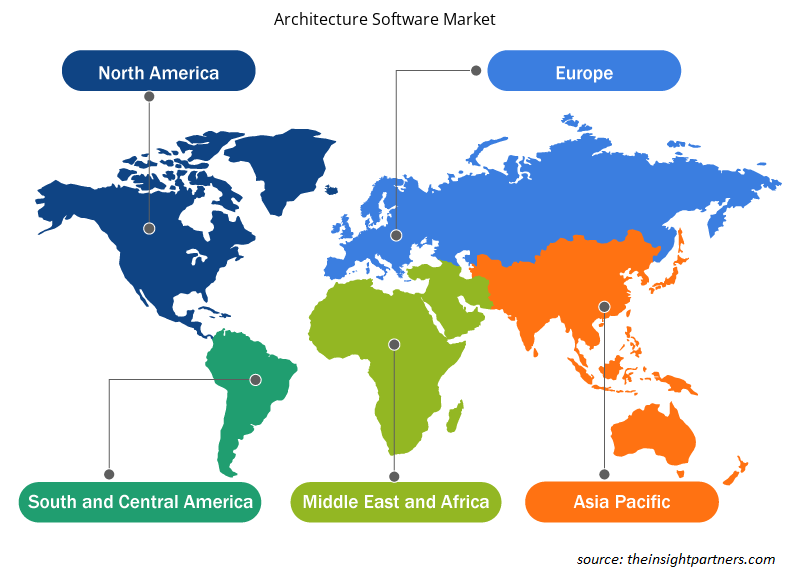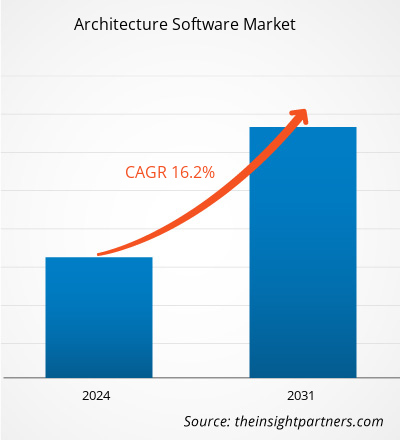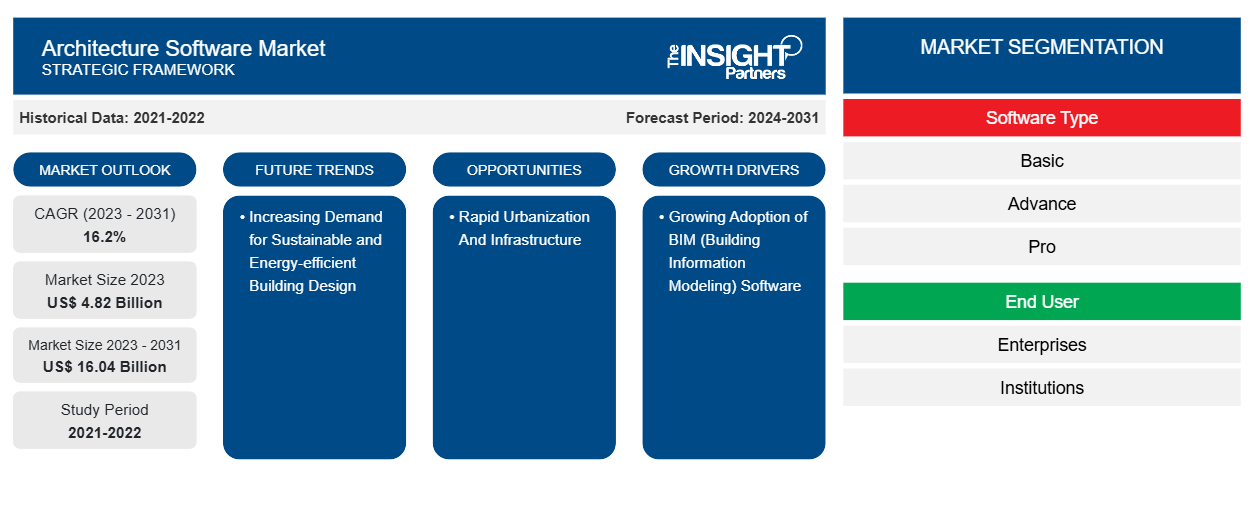Si prevede che la dimensione del mercato del software di architettura raggiungerà i 16,04 miliardi di dollari entro il 2031, rispetto ai 4,82 miliardi di dollari del 2023. Si prevede che il mercato registrerà un CAGR del 16,2% nel periodo 2023-2031. La crescente domanda di progettazione di edifici sostenibili ed efficienti dal punto di vista energetico rimarrà probabilmente una tendenza chiave nel mercato.CAGR of 16.2% during 2023–2031. The increasing demand for sustainable and energy-efficient building design is likely to remain a key trend in the market.
Analisi di mercato del software di architettura
La domanda di soluzioni software architettoniche spinge la necessità di rendere il processo di progettazione architettonica più semplice e meno dispendioso in termini di tempo, riducendo il tempo e il lavoro associati alle iterazioni di progettazione. Tecnologie avanzate come l'intelligenza artificiale, la realtà virtuale, la realtà aumentata e il cloud computing stanno facendo il loro ingresso nelle soluzioni software architettoniche e quindi contribuiscono alla crescita del mercato. Queste tecnologie migliorano la visualizzazione del progetto, la collaborazione e la gestione dei dati. Poiché la sostenibilità e l'efficienza energetica rimangono al centro dell'attenzione, si ottiene un'elevata domanda di soluzioni software architettoniche che consentano la progettazione di edifici ecologici e l'ottimizzazione energetica.
Panoramica del mercato del software di architettura
Il mercato globale del software per architetti si riferisce al settore che si occupa della fornitura di soluzioni software personalizzate per architetti e studi di architettura per aiutarli nelle diverse fasi del processo di progettazione architettonica. Il software per architetti si riferisce a qualsiasi pacchetto software contenente un set completo di strumenti e funzionalità che sono assemblati in modo da aiutare gli architetti a creare, analizzare e visualizzare progetti di edifici con una produttività, un'accuratezza e un'efficienza notevolmente migliorate. Queste soluzioni software di solito includono software CAD , software BIM, strumenti di modellazione e rendering 3D, software di gestione per progetti e piattaforme di collaborazione. Aiuteranno gli architetti a sviluppare progetti dettagliati in 2D e 3D, producendo disegni architettonici accurati, simulando le prestazioni dell'edificio e analizzando l'integrità dei componenti della struttura; possono ospitare illuminazione, componenti acustici, riscaldamento e aria condizionata.
Personalizza questo report in base alle tue esigenze
Riceverai la personalizzazione gratuita di qualsiasi report, comprese parti di questo report, o analisi a livello nazionale, pacchetto dati Excel, oltre a usufruire di grandi offerte e sconti per start-up e università
-
Scopri le principali tendenze di mercato in questo rapporto.Questo campione GRATUITO includerà analisi di dati che spaziano dalle tendenze di mercato alle stime e alle previsioni.
Driver e opportunità del mercato del software di architettura
Crescente adozione del software BIM (Building Information Modeling)BIM (Building Information Modelling) Software
Uno dei principali fattori di crescita nel mercato dei software di architettura è l'adozione sempre crescente, che porta a un aumento dell'uso del software di modellazione delle informazioni edilizie. Il software BIM consente una migliore progettazione, costruzione e gestione degli edifici, poiché fornisce un processo olistico per la creazione e la gestione delle informazioni di un progetto durante tutto il suo ciclo di vita, dalle fasi di progetto architettonico, ingegneristico e di costruzione. Consente di creare e gestire informazioni da varie discipline per aiutare a ottenere risultati di progetto migliori, migliorando al contempo la collaborazione tra le parti interessate. L'applicazione BIM sta crescendo anche dalle fasi di progettazione e costruzione alla gestione e manutenzione delle strutture, fornendo così una soluzione end-to-end per il settore AEC. L'adozione, quindi, diventa particolarmente vitale nei mercati emergenti come l'India, in cui il BIM è identificato come uno degli strumenti importanti per aiutare a migliorare l'efficienza delle costruzioni e, quindi, ridurre i costi correlati alla costruzione nel contesto di una rapida urbanizzazione e sviluppo delle infrastrutture.BIM software enables better designing, construction, and management of buildings, as it provides a holistic process for creating and managing a project's information throughout its lifecycle from architectural, engineering, and construction project stages. It allows creating and managing information from various disciplines to help achieve better project results while improving collaboration among stakeholders. BIM application is also growing from design and construction phases to facility management and maintenance, thus providing an end-to-end solution for the AEC industry. Adoption, therefore, becomes especially vital in emerging markets such as India, wherein BIM is identified as one of the important tools to help enhance construction efficiencies and, hence, reduce costs related to construction in the context of rapid urbanization and infrastructure development.
Rapida urbanizzazione e infrastrutture
I fornitori di software per architetti troveranno molto attraente la rapida urbanizzazione e lo sviluppo infrastrutturale del mercato emergente. Ora, con il boom dei progetti di sviluppo urbano e di costruzione in questi mercati emergenti, aumenterà la domanda di soluzioni software per architetti avanzate che facilitino una progettazione efficiente, una gestione dei progetti e una collaborazione. I fornitori di software per architetti hanno l'opportunità di soddisfare le esigenze specifiche dei mercati in via di sviluppo con soluzioni mirate ai codici edilizi locali, alle preoccupazioni ambientali e alle esigenze culturali. Inoltre, lo sviluppo in questi mercati comporta la costruzione di sistemi di trasporto, località residenziali e centri commerciali, tra gli altri, che richiedono software di architettura ad alta efficienza per supportare i progettisti di costruzione e progettazione, creando quindi un ambiente favorevole per i fornitori per avviare il lancio e diffondere i loro prodotti e servizi. Il software di architettura può essere adottato per standardizzare le procedure di progettazione e costruzione, specialmente nei mercati emergenti, dove si prevede che migliorerà l'efficienza e l'efficacia del settore.
Analisi della segmentazione del rapporto di mercato del software di architettura
Segmenti chiave che hanno contribuito alla derivazione dell'analisi del mercato del software di architettura: tipologia di software e utente finale.
- In base al tipo di software, il mercato è diviso in base, avanzato e pro. Il segmento avanzato ha detenuto una quota di mercato significativa nel 2023.
- In base all'utente finale, il mercato è segmentato in imprese, istituzioni e altri. Il segmento delle imprese ha detenuto una quota di mercato significativa nel 2023.
Analisi della quota di mercato del software di architettura per area geografica
L'ambito geografico del rapporto sul mercato dei software di architettura è suddiviso principalmente in cinque regioni: Nord America, Asia Pacifico, Europa, Medio Oriente e Africa, Sud e Centro America.
La regione nordamericana offre un immenso potenziale per il mercato del software architettonico, guidato dalla presenza di studi di architettura altamente avanzati e da attività di sviluppo infrastrutturale elevato. Inoltre, i paesi europei hanno una forte enfasi sull'architettura sostenibile; quindi, la richiesta di soluzioni software architettoniche che accelerino la progettazione di edifici ecologici e l'ottimizzazione energetica è più elevata. Il mercato dell'Asia Pacifica è spinto dalla rapida urbanizzazione, dallo sviluppo delle infrastrutture e dalle iniziative governative in paesi come Cina e India, che agiscono come fattori che accelerano l'adozione di soluzioni software architettoniche nella regione. Lo sviluppo di attività di costruzione e attività architettoniche in paesi come Brasile e Messico aumenta la domanda di soluzioni software architettoniche. Il crescente investimento in progetti infrastrutturali e iniziative di sviluppo urbano apre opportunità per l'adozione di software architettonico nella regione.
Approfondimenti regionali sul mercato del software di architettura
Le tendenze regionali e i fattori che influenzano il mercato del software di architettura durante il periodo di previsione sono stati ampiamente spiegati dagli analisti di Insight Partners. Questa sezione discute anche i segmenti e la geografia del mercato del software di architettura in Nord America, Europa, Asia Pacifico, Medio Oriente e Africa e America meridionale e centrale.

- Ottieni i dati specifici regionali per il mercato del software di architettura
Ambito del rapporto di mercato del software di architettura
| Attributo del report | Dettagli |
|---|---|
| Dimensioni del mercato nel 2023 | 4,82 miliardi di dollari USA |
| Dimensioni del mercato entro il 2031 | 16,04 miliardi di dollari USA |
| CAGR globale (2023-2031) | 16,2% |
| Dati storici | 2021-2022 |
| Periodo di previsione | 2024-2031 |
| Segmenti coperti |
Per tipo di software
|
| Regioni e Paesi coperti |
America del Nord
|
| Leader di mercato e profili aziendali chiave |
|
Densità dei player del mercato del software di architettura: comprendere il suo impatto sulle dinamiche aziendali
Il mercato del software di architettura sta crescendo rapidamente, spinto dalla crescente domanda degli utenti finali dovuta a fattori quali l'evoluzione delle preferenze dei consumatori, i progressi tecnologici e una maggiore consapevolezza dei vantaggi del prodotto. Con l'aumento della domanda, le aziende stanno ampliando le loro offerte, innovando per soddisfare le esigenze dei consumatori e capitalizzando sulle tendenze emergenti, il che alimenta ulteriormente la crescita del mercato.
La densità degli operatori di mercato si riferisce alla distribuzione di aziende o società che operano in un particolare mercato o settore. Indica quanti concorrenti (operatori di mercato) sono presenti in un dato spazio di mercato in relazione alle sue dimensioni o al valore di mercato totale.
Le principali aziende che operano nel mercato del software di architettura sono:
- Atto CAD LLC
- Autodesk Inc
- Bluebeam, Inc
- Prodotti
- Architetto capo, Inc.
- Società Corel
Disclaimer : le aziende elencate sopra non sono classificate secondo un ordine particolare.

- Ottieni una panoramica dei principali attori del mercato dei software di architettura
Notizie e sviluppi recenti sul mercato del software di architettura
Il mercato del software di architettura viene valutato raccogliendo dati qualitativi e quantitativi dopo la ricerca primaria e secondaria, che include importanti pubblicazioni aziendali, dati di associazioni e database. Di seguito sono elencati alcuni degli sviluppi nel mercato del software di architettura:
- Autodesk, Inc. (NASDAQ: ADSK) ha presentato Autodesk Informed Design, una soluzione basata su cloud che collega i flussi di lavoro di progettazione e produzione per semplificare il processo di progettazione e costruzione degli edifici. Informed Design consente agli architetti di lavorare con prodotti edilizi personalizzabili e predefiniti che producono risultati validi e ai produttori di condividere i loro prodotti con gli stakeholder della progettazione. Informed Design sblocca la costruzione industrializzata, ovvero l'applicazione dei principi di produzione all'ambiente costruito, e contribuirà a trasformare il settore dell'architettura, dell'ingegneria, della costruzione e delle operazioni (AECO).
(Fonte: AUTODESK INC., Comunicato stampa, febbraio 2024)
Copertura e risultati del rapporto sul mercato del software di architettura
Il rapporto "Dimensioni e previsioni del mercato del software di architettura (2021-2031)" fornisce un'analisi dettagliata del mercato che copre le seguenti aree:
- Dimensioni e previsioni del mercato del software di architettura a livello globale, regionale e nazionale per tutti i segmenti di mercato chiave coperti dall'ambito
- Tendenze del mercato del software di architettura, nonché dinamiche di mercato quali driver, vincoli e opportunità chiave
- Analisi dettagliata delle cinque forze PEST/Porter e SWOT
- Analisi di mercato del software di architettura che copre le principali tendenze del mercato, il quadro globale e regionale, i principali attori, le normative e i recenti sviluppi del mercato
- Analisi del panorama industriale e della concorrenza che copre la concentrazione del mercato, l'analisi della mappa di calore, i principali attori e gli sviluppi recenti per il mercato del software di architettura
- Profili aziendali dettagliati
- Analisi storica (2 anni), anno base, previsione (7 anni) con CAGR
- Analisi PEST e SWOT
- Valore/volume delle dimensioni del mercato - Globale, Regionale, Nazionale
- Industria e panorama competitivo
- Set di dati Excel
Report recenti
Rapporti correlati
Testimonianze
Motivo dell'acquisto
- Processo decisionale informato
- Comprensione delle dinamiche di mercato
- Analisi competitiva
- Analisi dei clienti
- Previsioni di mercato
- Mitigazione del rischio
- Pianificazione strategica
- Giustificazione degli investimenti
- Identificazione dei mercati emergenti
- Miglioramento delle strategie di marketing
- Aumento dell'efficienza operativa
- Allineamento alle tendenze normative























 Ottieni un campione gratuito per - Mercato del software di architettura
Ottieni un campione gratuito per - Mercato del software di architettura